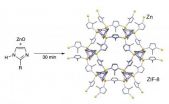(Press-News.org) An international team of genetics researchers has discovered four new gene regions that contribute to low birth weight. Three of those regions influence adult metabolism, and appear to affect longer-term outcomes such as adult height, risk of type 2 diabetes and adult blood pressure.
"This large study adds to the evidence that genes have a strong influence on fetal growth," said one of the co-authors, Struan F.A. Grant, Ph.D., associate director of the Center for Applied Genomics at The Children's Hospital of Philadelphia. "The cumulative effect of the genes is surprisingly strong; it's equivalent to the effect of maternal smoking, which is already recognized as lowering a baby's weight at birth. We already know that a low birth weight increases the risk of health problems in adult life."
The article, published today in Nature Genetics, was the second major study on birth weight by the Early Growth Genetics (EGG) Consortium, composed of groups of scientists from multiple countries, including the United Kingdom, Finland, the Netherlands, and the United States. Earlier this year, Grant was the lead investigator of an EGG study—the largest-ever genome-wide study of common childhood obesity—which found two novel gene variants that increase the risk of that condition.
The lead investigator of the current study was Rachel M. Freathy, Ph.D., a Sir Henry Wellcome Postdoctoral Fellow from the University of Exeter Medical School in the U.K.
The meta-analysis and follow-up study encompassed nearly 70,000 individuals, of European, Arab, Asian and African American descent, from across 50 separate studies of pregnancy and birth. In addition to confirming that three previously discovered genetic regions increased the risk of low birth weight, the consortium discovered four new regions: genes HMGA2, LCORL, ADRB1, and a locus on chromosome 5.
Two of the previously identified gene regions are connected to a risk of type 2 diabetes, while two of the newly found regions confer a risk of shorter adult stature. A third region, ADRB1, is associated with adult blood pressure—the first time that scientists have found a genetic link common to both birth weight and blood pressure.
The biological mechanisms by which the identified genetic regions function to influence early growth and adult metabolism remain to be discovered, although, said Grant, these regions offer intriguing areas on which to focus follow-up research.
Freathy, the study's lead investigator, summed up the study's findings by saying, "These discoveries give us important clues to the mechanisms responsible for the control of a baby's growth in the womb, and may eventually lead to a better understanding of how to manage growth problems during pregnancy."
"This study demonstrates that genes acting early in development have important effects on health both in childhood and beyond," added Grant. "While we continue to learn more about the biology, an important implication is that designing prenatal interventions to improve birth weight could have lifelong health benefits."
###
Financial support for this study came from the National Institutes of Health (R01 HD056465), the Wellcome Trust, the Netherlands Organization for Scientific Research, the European Union, the Medical Research Council in the U.K., and the Academy of Finland.
"New loci associated with birth weight identify genetic links between intrauterine growth and adult height and metabolism," Nature Genetics, advance online publication, Dec. 2, 2012. doi:10.1038/ng.2477
About The Children's Hospital of Philadelphia: The Children's Hospital of Philadelphia was founded in 1855 as the nation's first pediatric hospital. Through its long-standing commitment to providing exceptional patient care, training new generations of pediatric healthcare professionals and pioneering major research initiatives, Children's Hospital has fostered many discoveries that have benefited children worldwide. Its pediatric research program is among the largest in the country, ranking third in National Institutes of Health funding. In addition, its unique family-centered care and public service programs have brought the 516-bed hospital recognition as a leading advocate for children and adolescents. For more information, visit http://www.chop.edu.
Genes linked to low birth weight, adult shortness and later diabetes risk
Researchers at The Children's Hospital of Philadelphia part of a large international study
2012-12-03
ELSE PRESS RELEASES FROM THIS DATE:
Scientists at Scripps Research Institute discover how 2 proteins help keep cells healthy
2012-12-03
LA JOLLA, CA – December 2, 2012 – Scientists at The Scripps Research Institute (TSRI) have determined how two proteins help create organelles, or specialized subunits within a cell, that play a vital role in maintaining cell health. This discovery opens the door for research on substances that could interfere with the formation of these organelles and lead to new therapies for cancer.
The study, published online ahead of print on December 2, 2012, by the journal Nature Structural & Molecular Biology, focuses on the structure and function of the two proteins, ATG12 and ...
Scientists find 'bully' genes in common childhood tumor
2012-12-03
In a genome sequencing study of 74 neuroblastoma tumors in children, scientists at the Johns Hopkins Kimmel Cancer Center and the Children's Hospital of Philadelphia (CHOP) found that patients with changes in two genes, ARID1A and ARID1B, survive only a quarter as long as patients without the changes. The discovery could eventually lead to early identification of patients with aggressive neuroblastomas who may need additional treatments.
Neuroblastomas affect nerve tissue throughout the body and are the most common, non-blood cancer in children. "These cancers have a ...
Origin of intelligence and mental illness linked to ancient genetic accident
2012-12-03
Scientists have discovered for the first time how humans – and other mammals – have evolved to have intelligence.
Researchers have identified the moment in history when the genes that enabled us to think and reason evolved.
This point 500 million years ago provided our ability to learn complex skills, analyse situations and have flexibility in the way in which we think.
Professor Seth Grant, of the University of Edinburgh, who led the research, said: "One of the greatest scientific problems is to explain how intelligence and complex behaviours arose during evolution." ...
Childhood trauma leaves mark on DNA of some victims
2012-12-03
This press release is available in German.
Abused children are at high risk of anxiety and mood disorders, as traumatic experience induces lasting changes to their gene regulation. Scientists from the Max Planck Institute of Psychiatry in Munich have now documented for the first time that genetic variants of the FKBP5 gene can influence epigenetic alterations in this gene induced by early trauma. In individuals with a genetic predisposition, trauma causes long-term changes in DNA methylation leading to a lasting dysregulation of the stress hormone system. As a result, ...
A shock to pollution in chemistry
2012-12-03
Solvents are omnipresent in the chemical industry, and are a major environmental and safety concern. Therefore the large interest in mechanochemistry: an energy-efficient alternative that avoids using bulk solvents and uses high-frequency milling to drive reactions. Milling is achieved by the intense impact of steel balls in a rapidly moving jar, which hinders the direct observation of underlying chemistry. Scientists have now for the first time studied a milling reaction in real time, using highly penetrating X-rays to observe the surprisingly rapid transformations as ...
Cell surface transporters exploited for cancer drug delivery
2012-12-03
CAMBRIDGE, Mass. (December 2, 2012) –Whitehead Institute scientists report that certain molecules present in high concentrations on the surfaces of many cancer cells could be exploited to funnel lethal toxic molecules into the malignant cells. In such an approach, the overexpression of specific transporters could be exploited to deliver toxic substances into cancer cells.
Although this finding emerges from the study of a single toxic molecule and the protein that it transports, Whitehead Member David Sabatini says this phenomenon could be leveraged more broadly.
"Our ...
Surprising results from study of non-epileptic seizures
2012-12-03
MAYWOOD, Il. - A Loyola University Medical Center neurologist is reporting surprising results of a study of patients who experience both epileptic and non-epileptic seizures.
Non-epileptic seizures resemble epileptic seizures, but are not accompanied by abnormal electrical discharges. Rather, these seizures are believed to be brought on by psychological stresses.
Dr. Diane Thomas reported that 15.7 percent of hospital patients who experienced non-epileptic seizures also had epileptic seizures during the same hospital stay. Previous studies found the percentage of such ...
A better way to make chemicals?
2012-12-03
Bulk solvents, widely used in the chemical industry, pose a serious threat to human health and the environment. As a result, there is growing interest in avoiding their use by relying on "mechanochemistry" – an energy-efficient alternative that uses high-frequency milling to drive reactions. Because milling involves the intense impact of steel balls in rapidly moving jars, however, the underlying chemistry is difficult to observe.
Now, for the first time, scientists have studied a milling reaction in real time, using highly penetrating X-rays to observe the surprisingly ...
Glowing fish shed light on metabolism
2012-12-03
A tiny, translucent zebrafish that glows green when its liver makes glucose has helped an international team of researchers identify a compound that regulates whole-body metabolism and appears to protect obese mice from signs of metabolic disorders.
Led by scientists at the University of California, San Francisco (UCSF), the work demonstrates how a fish smaller than a grain of rice can help screen for drugs to help control obesity, type 2 diabetes and other metabolic disorders, which affect a rising 34 percent of American adults and are major risk factors for cardiovascular ...
Stanford researchers discover master regulator of skin development
2012-12-03
STANFORD, Calif. — The surface of your skin, called the epidermis, is a complex mixture of many different cell types — each with a very specific job. The production, or differentiation, of such a sophisticated tissue requires an immense amount of coordination at the cellular level, and glitches in the process can have disastrous consequences. Now, researchers at the Stanford University School of Medicine have identified a master regulator of this differentiation process.
"Disorders of epidermal differentiation, from skin cancer to eczema, will affect roughly one-half ...
LAST 30 PRESS RELEASES:
Neuroscientists devise formulas to measure multilingualism
New prostate cancer trial seeks to reduce toxicity without sacrificing efficacy
Geometry shapes life
A CRISPR screen reveals many previously unrecognized genes required for brain development and a new neurodevelopmental disorder
Hot flush treatment has anti-breast cancer activity, study finds
Securing AI systems against growing cybersecurity threats
Longest observation of an active solar region
Why nail-biting, procrastination and other self-sabotaging behaviors are rooted in survival instincts
Regional variations in mechanical properties of porcine leptomeninges
Artificial empathy in therapy and healthcare: advancements in interpersonal interaction technologies
Why some brains switch gears more efficiently than others
UVA’s Jundong Li wins ICDM’S 2025 Tao Li Award for data mining, machine learning
UVA’s low-power, high-performance computer power player Mircea Stan earns National Academy of Inventors fellowship
Not playing by the rules: USU researcher explores filamentous algae dynamics in rivers
Do our body clocks influence our risk of dementia?
Anthropologists offer new evidence of bipedalism in long-debated fossil discovery
Safer receipt paper from wood
Dosage-sensitive genes suggest no whole-genome duplications in ancestral angiosperm
First ancient human herpesvirus genomes document their deep history with humans
Why Some Bacteria Survive Antibiotics and How to Stop Them - New study reveals that bacteria can survive antibiotic treatment through two fundamentally different “shutdown modes”
UCLA study links scar healing to dangerous placenta condition
CHANGE-seq-BE finds off-target changes in the genome from base editors
The Journal of Nuclear Medicine Ahead-of-Print Tip Sheet: January 2, 2026
Delayed or absent first dose of measles, mumps, and rubella vaccination
Trends in US preterm birth rates by household income and race and ethnicity
Study identifies potential biomarker linked to progression and brain inflammation in multiple sclerosis
Many mothers in Norway do not show up for postnatal check-ups
Researchers want to find out why quick clay is so unstable
Superradiant spins show teamwork at the quantum scale
Cleveland Clinic Research links tumor bacteria to immunotherapy resistance in head and neck cancer
[Press-News.org] Genes linked to low birth weight, adult shortness and later diabetes riskResearchers at The Children's Hospital of Philadelphia part of a large international study




